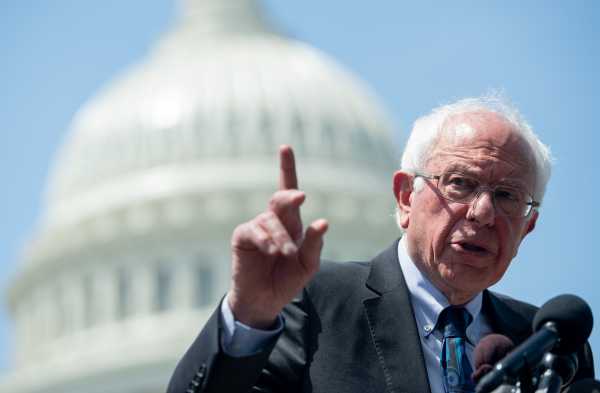
Bernie Sanders’s free public college and debt relief plan has put him in a familiar position — getting criticized by wonky policy types for how his proposed plan is designed — but in a less familiar way: The criticism is his plan is too friendly to the well-off.
Sanders’s plan, released Monday, would cancel all of the $1.6 trillion student debt held by Americans. But from the centrists at Third Way to the leftist Matt Bruenig’s People’s Policy Project and New America in between, Sanders’s debt cancellation plan has been criticized by policy wonks for lavishing a large proportion of the overall monetary benefit on people with high incomes who have expensive graduate degrees (doctors, lawyers, business people, etc.).
While the most sympathetic beneficiary of debt cancellation would be, say, someone in their 20s or 30s with a useless degree or even just some credits from a for-profit college, mired in a low-wage job while also trying to make student debt payments, that’s hardly the whole universe of people who would benefit immediately from Sanders’s plan.
”We believe that blanket debt forgiveness in general is bad policy that primarily benefits upper middle-class people who attended elite four-year colleges, and does nothing to appeal to the bulk of Americans who don’t have a college degree,” Third Way’s Tamara Hiler told Inside Higher Ed. New America’s Kevin Carey wrote in the New York Times that Sanders’s plan would largely benefit graduate students and would do little to prevent the incurring of future student loan debt.
Meanwhile, Bruenig criticized the plan (and student debt forgiveness in general) as “confusing” and “undertheorized,” wrote that the plan was both too big and too small, meaning it would benefit people who had expensive graduate degrees before 2021 and do nothing for those after and for “people who drained $50,000 off their net worth to pay for an undergraduate degree at a public college — but who do not currently carry student debt.”
This is not the first time a Sanders plan has angered a wide range of Democratic-aligned think-tankers for violating their principles for how policy should be designed. The debate shows that Sanders, even more so than his fellow progressive Elizabeth Warren, is trying to enact a paradigm shift in how Democrats think of policy, infusing it with a moralized perspective unbounded by the normal constraints policymakers spend so much time worrying about.
The Sanders plan, explained
The Sanders plan would wipe out the $1.6 trillion worth of student debt and provide funding for states and tribes to institute free two-and-four year college at public universities, using a two-for-one match program with states and tribes that would cost about $48 billion per year. It would also cap interest rates on new federal student debt, which can be used to pay for undergraduate or graduate education.
To pay for all this, Sanders would implement a tax on financial transactions that would generate $2.4 trillion over 10 years to pay for the $2.2 trillion debt relief and college accessibility plan.
Who exactly would benefit from a broad debt-forgiveness plan?
Student debt is not evenly distributed throughout the population; much of it is held by relatively high-income households with graduate degrees. According to the Urban Institute, about a third of student debt held by people over 25 comes from the top quarter of the income distribution, or households with $97,000 in income or above. The top ten percent of the income distribution, or those $173,000 in income or above, have about 11 percent of the total debt, while those households with $27,000 or less in income, the lowest quartile, have 12 percent of the debt.
Just in pure dollars, universal debt cancellation programs would be a one-time cash transfer for which a large portion of the benefits would go to those who have high incomes — a point that critics stress.
Sanders and his supporters have a few responses. One, they argue that universal programs that are simple to understand are more likely to garner political support and are more enduring once they’re implemented. Also, the truly well-off are actually less likely to have any student debt, while many people with graduate degrees are not necessarily well-off. Some proponents of debt relief go further, arguing that the entire premise of taking out debt to pay for college is misbegotten, and that it’s a matter of justice, not just economics, to rectify it.
Furthermore, there may be substantial economic and social benefits from debt relief, including spurring household formation and home-buying by younger people, according to the Levy Institute.
And while some are skeptical of any form of debt cancellation on account of the higher wages college graduates have as opposed to non-graduates, many of the borrowers most at risk of financial distress and default are so-called “nontraditional” students who attended something besides a four-year undergraduate institution, like a for-profit, garnering an essentially worthless education that still leaves them with debt they can’t repay.
Existing programs that offer some debt relief — including debt cancellation for students who attended colleges engaged in fraud or public service loan forgiveness — are at the mercy of Education Departments that may not be interested in carrying them out to their maximum potential.
Sanders is not the only person who is behind this plan. He’s joined by some of the most prominent progressive House members, including Reps. Ilhan Omar (MN), Alexandria Ocasio-Cortez (NY), and Pramila Jayapal (WA).
In other words, these are not people who take their cues from the center-left wonk class that has been ripping apart their plan since Monday.
Why wonks hate Sanders’s plan — and why Sanders’s supporters don’t care
The way many professional policy types think about public policy is to identify a specific problem and then allocate funds toward it in the most efficient way without spilling over to other people who aren’t affected by the problem. That’s one big reason why Sanders’s plan has been largely panned by policy wonks.
Kevin Carey of New America, citing Education Department data, says that “only 45 percent of student loans are used to attend public colleges and universities,” while “40 percent of loans are taken out to attend graduate or professional school.”
And among graduate schools, it’s the professional schools — law, medicine, etc — where the debt really piles up. The average loan balance for those who completed medical school jumped from $124,700 in 1999-2000 to $246,000 in 2015-2016, according to the National Center for Education Statistics. Those professionals would definitely benefit from a debt forgiveness plan.
Besides the question of progressivity and regressivity, there is also the “horizontal equity” issue. This idea is that people in similar situations should get similar treatment — people who incurred student debts and presumably faced the same high costs of education and poor economic environment and yet managed to pay them off would get nothing.
While many supporters of the plan find this objection to be ridiculous — after all, this could be used to object to any number of broadly dispersed benefit programs (the sick benefit from health care subsidies, the poor from welfare and cash transfers) — it still exposes what some analysts say is a conceptual gap in student debt forgiveness.
Critics like Carey and Slate’s Jordan Weissman have also pointed out that Sanders’s plan would do little to contain the debt burdens faced by new graduate students, whose predecessors will have recently gotten a full jubilee. And, as Carey argues, by establishing the principle of debt forgiveness for all debt, colleges may feel like they can even charge more for graduate school and students would be more likely to take on more debt.
These criticisms don’t seem to be taken seriously by many in Sanders’s camp. And there’s even some evidence that alienating the wonk class isn’t a bug that comes from Sanders’s ambitions but a feature.
As several of the liberal writers and analysts who criticized Sanders’s plan have pointed out, when they make some of the arguments described above, they have been the recipient, on Twitter at least, of some sarcastic, vitriolic, and mocking responses from those further to their left.
What the debt-forgiveness debate says about Warren vs. Sanders
Now, Sanders and his band of socialist-adjacent House members are not the only ones with a student debt relief plan.
Elizabeth Warren has a similarly expansive debt relief plan, but it includes some provisions to limit aid to higher-income debtors. While it was still criticized by many of Sanders’s critics as being “regressive,” these criticisms did not touch off the same amount of vitriol among Warren’s supporters, at least online.
This points to some temperamental and intellectual differences between the two.
“Warren has carved out a space for herself as a detailed policy wonk who is more palatable to moderates than Sanders, a self-described democratic socialist. And Sanders has favored sweeping, easy-to-understand plans that are at the vanguard of the party’s most progressive wing — presenting himself as unbowed to the concerns of centrists,” BuzzFeed’s Molly Hensley Clancy argued.
Debt relief is not an idea that rose from the wonk class. Debt jubilees go back to the Bible and in their modern form were advocated by the radical anthropologist David Graeber, along with particular emphasis on student debt from activists connected to Occupy Wall Street. Sanders and his supporters have a highly moralized and confrontational approach to public policy that can supercharge disagreements over policy design into ones about whether you’re on the side of the masses or the 1 percent.
What Sanders, and to some extent Warren as well, is arguing is that the system of student debt is fundamentally noxious and should be ripped out root and branch. Sanders also is a fan of universality in all its guises, most especially in health care, while Ocasio-Cortez has pointed to non-means-tested institutions like the library as an example of the type of socialism she supports.
They also tend to see the wonk class’s obsession with deserving versus undeserving and less spending as opposed to more as fundamentally self-limiting. After all, conservatives don’t design tax cuts or military spending with this kind of green-eyeshade obsession with who’s deserving and who isn’t — why should progressives shackle themselves like this?
That both Sanders and Ocasio-Cortez have shown openness to much higher taxes (on the rich at least) or alternative ways of looking at budgeting and spending that don’t respect traditional fiscal constraint is consistent with this approach to public policy.
And if the space for public policy is really as wide as Sanders and Ocasio-Cortez argue, why wouldn’t you go all the way?
Sourse: vox.com






